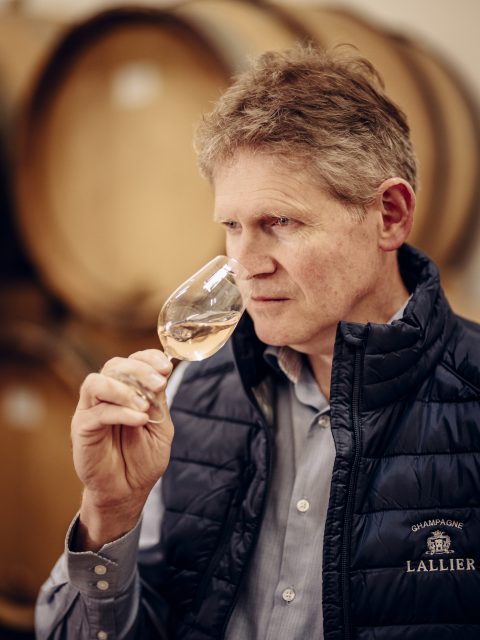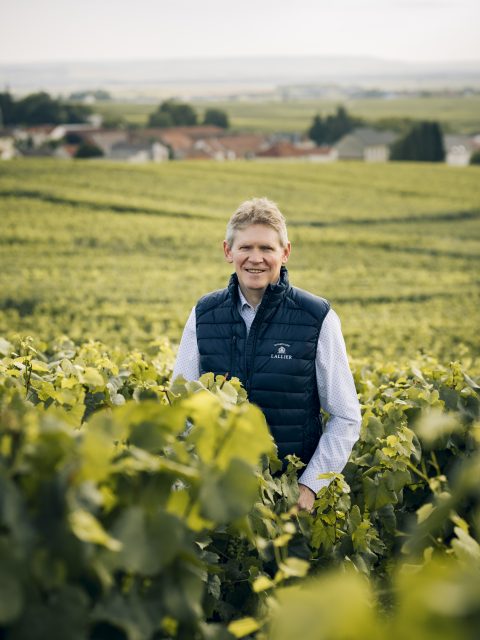This website uses cookies so that we can provide you with the best user experience possible. Cookie information is stored in your browser and performs functions such as recognising you when you return to our website and helping our team to understand which sections of the website you find most interesting and useful.
Meet the maker: Dominique Demarville
Formerly of Veuve Clicquot, the eminent cellarmaster joined Lallier in January 2021 following its acquisition by Campari Group. He shares his fascination for native yeasts, low dosage wines, and love for fly fishing with Douglas Blyde…

What is the Lallier style?
Each house has its own philosophy from which its style arises. When I first had the opportunity to taste Lallier’s range two years ago, what impressed me was the balance its wines achieve between the four pillars of “purity” from chalk, “freshness” from our cool climate, and the “intensity” and “depth” derived from the grapes to the blending, and also from ageing. Our Series “R” and flagship “Ouvrage” capture these “emotions”. R, for Reflexion shows a touch of the year across 50 villages as well as older wines, while Ouvrage encapsulates two Grand Cru parcels: Oger on the Côte des Blancs and Aÿ on the Montagne de Reims.
What special work with yeasts have you been undertaking at Lallier?
At the end of the twentieth century we were left with three main varieties of yeast in Champagne which have done a wonderful job at stabilising fermentation and bringing consistency of flavour. However, a few years ago, Lallier’s general manager, Frances Tribaut begun work on selecting yeasts found naturally within specific parcels which he would then apply to fermentations from those sites. I have continued his work this year, selecting yeasts from our vineyards in Loridon and Cuis and it has been very interesting to see what happened. This form of “parcellaire” winemaking provides me with a diversity of wines showing intensity, and a deeper touch when assembling a blend. It is also very important for us to keep our wines on their lees whether in tanks or in barrels. Even when the yeasts from fermentation have died, they still give to the wine, particularly texturally.
What other ways have you pleasantly disrupted Champagne?
Each year I start from a blank page depending on what nature brings. Terroir is fascinating. When you have a cru which is mostly known for Pinot Noir, as in our home of Aÿ, yet you have a beautiful vineyard of Chardonnay, it can be very exciting to discover what the Chardonnay can bring you. Also, I have been exploring sixty year old Pinot Meunier planted in Cuis in the Côte des Blancs where Chardonnay otherwise dominates. It is a question of curiosity.
How would you describe your relationship with Francis Tribaut?
Very good. Francis did a wonderful job from 2004 to 2020 to develop Lallier on the market and to communicate the roots of Lallier. We meet every two or three weeks when I invite him to taste my work. He brings a sense of continuity, quality and consistency. I also work closely with Frederic Olivier, Production Manager, who has been with Lallier for 28 years. We actually went to school together thirty years ago and it is nice to finally have the opportunity to finally work altogether.
Why are you taking the decision to deploy oak barrels which have been coopered in the Champagne region?
It is both a question of furthering a human relationship and wishing to source locally, including barrels made from Champagne’s beautiful forests. We only have one cooperage in Champagne led by Jérôme Viard whom I’ve known a long time though never had the opportunity to work with before. Last June, I had the chance to visit him at the Tonnellerie de Champagne. Using wood coming from very close to Lallier appeals in the same way as drawing yeasts from our vineyards, leading to increased precision in blending at the highest level.
What proportion of vineyards which Lallier manages does it also own?
Roughly 10% of our needs are met by our own Chardonnay-dominated vineyards, which are mostly very well situated in the Côte des Blancs, Aÿ and in Verzenay in the Montagne de Reims.
Is one of Lallier’s missions to “go green”, and what steps have been taken to realise this aim?
Biodiversity is something I am sensitive to and it is crucial we ensure the transmission of beautiful vineyards to the next generation. We want to be greener in everything we are doing, especially in the vineyards, which are certified “HVE” (Haute Valeur Environnementale). We intend to phase out the use of herbicides entirely by 2024, while trialling organic production over several parcels. We have also invested in tractors to cultivate the soil. I work closely with Cyrille Diniz, Technical Director and Mathieu Pingret, Vineyard Manager. We are looking at the weight of our bottles and the amount of packaging. And in the winery we are assessing the carbon impact, including looking into solar power. On that note, last year we hired Camille Seite, Oenologist and QHSE Manager (Quality Health Safety and Environment) to support with producing a sustainability audit.

Are you likely to release a zéro-dosage wine?
Low dosage is already part of Lallier’s DNA. It could be interesting to have a zero dosage, though such an approach can lead to wines which can be too linear, green and sharp while lacking in texture. We must follow our consumers, most of whom like a delicate sweetness which is often what awakens their senses, while others are interested by zero dosage and it is important for a house like Lallier to consider allowing them the opportunity to enjoy such a Champagne when a perfect balance can be achieved..
And a Coteaux Champenois?
Our energy goes into effervescence though we have beautiful parcels, ageing under oak, which gives us the opportunity for a potential still wine. Though I do not believe such a wine would be intended for sale but for guests coming to Lallier to enjoy.
Given Campari Group acquired the Maison in May 2020, is Lallier the first Italian-owned Champagne house?
I believe it is first house in Champagne to see Italian investment. When we welcomed Luca Garavoglia, chairman of the Campari Group to Lallier, the discussion was always about quality – how to make great wine and how to enhance the perception of Lallier.
If not guiding sapid Champagnes to fruition, what other job might you have done?
In life much of what you do as a young person informs what you do later on, and I spent my teenage years studying in Burgundy, so why not make wine there? I love to produce things coming from the soil, so maybe also a farmer.
Tell us something unusual about yourself?
I love to be close to nature, water in particular, and I greatly enjoy fly fishing, getting clues from how insects behave around the surface, then catching a trout or a salmon before letting it go. The I am also enjoy spending any time I can with my wonderful family, including three children and our two golden retrievers, the younger of which comes fishing with me.
What is your last word?
I want to bring pleasure to people who drink Lallier. This is why I wake up every morning: to make sure when somebody opens a bottle it will bring them joy.
Lallier is imported by Whisky Exchange and Amathus.
Related news
Grammy-winning Ariana Grande bewitched by Barolo

